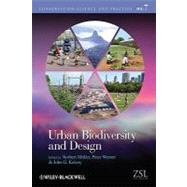
Note: Supplemental materials are not guaranteed with Rental or Used book purchases.
Purchase Benefits
What is included with this book?
David Knight is the Team Leader for Biodiversity, Plants and Fungi with Natural England. David has worked for more than twenty years in biodiversity and nature conservation in England, particularly in urban areas. His experience ranges from the reclamation of colliery tips and derelict land to influencing policy for the conservation or urban biodiversity. David gained 'hands-on' experience from work in protecting and managing urban habitats with local government. He also worked on a major urban forestry project in West Yorkshire, the White Rose Forest, before going on to join English Nature as their Urban Adviser. This included acting as Executive Editor for the magazine 'Urbio'. More recently David has been involved in commissioning research into the biodiversity of urban domestic gardens, developing a performance indicator on biodiversity for local government in England and getting recognition for the value of open mosaic habitats on previously developed land in the UK Biodiversity Action Plan.
Peter Werner is senior researcher at the Institute for Housing and Environment in Darmstadt, Germany. He started his scientific career with a research project about the ecological importance of industrial wastelands in the city ofBerlin in the years 1981 to 1983. Also, at this time Professor Herbert Sukopp and Peter Werner wrote the review "Nature in Cities" published by the European Council. Since 1983 he works at the Institute for Housing and Environment and his main research area is urban ecology in the widest sense including urban sustainable development. He was editor of several bibliographies and planning guides concerning urban ecology and published numerous papers in the area of urban nature and ecological development. In 2005 he founded together with other German scientists the competence network urban ecology CONTUREC, since then he is the executive secretary of CONTUREC.
| Contributors | |
| Foreword | |
| Preface | |
| Introduction | |
| Urban Biodiversity and the Case for Implementing the Convention on Biological Diversity in Towns and Cities | |
| Fundamentals of Urban Biodiversity | |
| Biodiversity ofUrban-IndustrialAreas and its Evaluation - a Critical Review | |
| Cultural Aspects of Urban Biodiversity | |
| Social Aspects of Urban Biodiversity - an Overview | |
| Urban Biodiversity and Climate Change | |
| Design and Future of Urban Biodiversity | |
| Urban Patterns and Biological Diversity: A Review | |
| History and Development of Urban Biodiversity | |
| Urban Flora: Historic, Contemporary and Future Trends | |
| Environmental History and Urban Colonizations from an Avian Perspective | |
| Constraints of Urbanization on Vegetation Dynamics in a Growing City: A Chronological Framework in Rennes (France) | |
| Most Frequently Occurring Vascular Plants and the Role of Non-native Species in Urban Areas - a Comparison of Selected Cities in the Old and the NewWorlds | |
| Factors Influencing Non-Native Tree Species Distribution in Urban Landscapes | |
| Analysis and Evaluation of Biodiversity in Cities | |
| Towards an Automated Update of Urban Biotope Maps Using Remote Sensing Data: What is Possible? | |
| Analysis of the Planted and Spontaneous Vegetation at Selected Open Spaces in Apipucos District of Recife, Brazil | |
| Multivariate Approaches to the Study of Urban Biodiversity and Vegetation: An Example from a Southern Temperate Colonial City, Christchurch, New Zealand | |
| The Biodiversity of Historic Domestic Gardens - A Study in the Wilhelminian Quarter of Erfurt (Germany) | |
| Old Masonry Walls as Ruderal Habitats for Biodiversity Conservation and Enhancement in Urban Hong Kong | |
| Green Roofs - Urban Habitats for Ground-Nesting Birds and Plants | |
| South Atlantic Tourist Resorts: Predictors for Changes Induced by Afforestation | |
| Social Integration and Education for Biodiversity | |
| Urban Green Spaces: Natural and Accessible? The Case of Greater Manchester, UK | |
| UrbanWastelands -A Chance for Biodiversity in Cities? Ecological Aspects, Social Perceptions and Acceptance of Wilderness by Residents | |
| Perception of Biodiversity - The Impact of School Gardening 425 | |
| Landscape Design and Children's Participation in a Japanese Primary School - Planning Process of School Biotope for 5 Years | |
| Attracting Interest in Urban Biodiversity with Bird Studies in Italy | |
| Allotment Gardens as Part of Urban Green Infrastructure: Actual Trends and Perspectives in Central Europe | |
| Conservation, Restoration and Design for Biodiversity | |
| Integration ofNatural Vegetation in Urban Design - Information, Personal Determination and Commitment | |
| Prospects of Biodiversity in the Mega-City of Karachi, Pakistan: Potentials, Constraints and Implications | |
| Potential of Biodiversity and Recreation in Shrinking Cities: Contextualization and Operationalization | |
| Near-Natural Restoration Strategies in Post-mining Landscapes | |
| Restoration and Design of Calcareous Grasslands in Urban and Suburban Areas: Examples from the Munich Plain | |
| Contribution of Landscape Design to Changing Urban Climate Conditions | |
| Economics and the Convention on Biodiversity: Financial Incentives for Encouraging Biodiversity in Nagoya | |
| Conclusions | |
| Index | |
| Table of Contents provided by Publisher. All Rights Reserved. |
The New copy of this book will include any supplemental materials advertised. Please check the title of the book to determine if it should include any access cards, study guides, lab manuals, CDs, etc.
The Used, Rental and eBook copies of this book are not guaranteed to include any supplemental materials. Typically, only the book itself is included. This is true even if the title states it includes any access cards, study guides, lab manuals, CDs, etc.